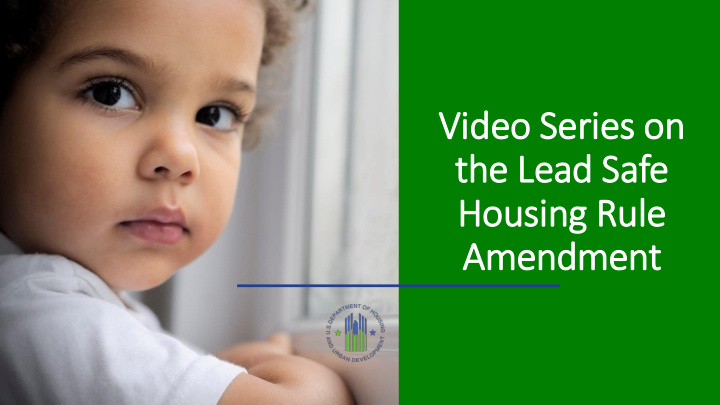



Vid ideo Serie ies on the Lead Safe Housing Rule Amendment
Learning Objectives • Understand the scope, requirements, and key definitions of Lead Safe Housing Rule (LSHR) amendment. • Be prepared to respond effectively and quickly to elevated blood lead level (EBLL) cases. • Know where to go for additional resources and help.
Topics Covered • Introduction to Lead Hazards in Housing • EBLL Response in Public Housing • EBLL Response in Housing Choice Voucher Units • EBLL Response in Project-Based Voucher Units
Key Acronyms • LSHR: Lead Safe Housing Rule • PHA: Public Housing Agency • HCV: Housing Choice Voucher program • PBV: Project-Based Voucher program • EBLL: Elevated Blood Lead Level • EI: Environmental Investigation
Overview of Lead Hazards in Housing
Health Effects of f Lead • Lead is a highly toxic metal that can cause a range of health problems, especially in young children: behavioral problems, learning disabilities, seizures, and even death. • Children who are lead poisoned may show no symptoms. • There is no known safe level of lead exposure.
Household Sources of Lead • Lead can be found in • Paint in homes built before 1978; • Water pumped through lead pipes; and • Certain imported items including clay pots, toys, jewelry, and home remedies.
Children and Lead Poisoning • How can children become lead poisoned? • Putting their hands or other lead-contaminated objects into their mouths. • Playing in lead-contaminated soil. • Eating paint chips found in homes with peeling or flaking lead- based paint. • Pediatricians can check for lead poisoning with a simple blood test.
Lead Safe Housing Rule (LSHR) and LSHR Amendment
The Lead Safe Housing Rule (L (LSHR) • Title 24 Code of Federal Regulations (CFR) Part 35, subparts B – R: • Subpart L – Public Housing Programs • Subpart M – Tenant-Based Rental Assistance • Subpart H – Project-Based Rental Assistance (includes PBV) • Implemented in conjunction with other applicable Federal, State, and local regulations
The LSHR (c (cont.) • Your PHA is responsible for ensuring that federally-assisted, pre-1978 units are free of hazards from lead-based paint. This includes • Responding swiftly and effectively to reports of EBLLs among children in federally-assisted target units; • Providing tenants with lead disclosure form and “Protect Your Family from Lead in Your Home” pamphlet; and • Inspecting units annually.
Which Units Are Covered? • All federally-assisted and federally-owned housing constructed prior to 1978, with certain exceptions.
Which Units Are Exempt? • Units constructed after January 1, 1978. • Zero-bedroom units and SROs. • Housing for the elderly or a residential property designated exclusively for persons with disabilities. • Exemption does not apply if a child less than age six resides or is expected to reside in the dwelling unit.
Exemptions (c (cont.) • Properties found to be lead-free by a LBP inspection. • Properties where all LBP has been identified, removed, and clearance achieved. • Unoccupied properties to be demolished which remain unoccupied until demolition.
The LSHR: Key Terms • Target housing: Housing constructed prior to 1978 and subject to the LSHR. • Assisted units: Target housing assisted under Sections 8 and 9 of the United States Housing Act of 1937.
The LSHR: Key Terms • Index unit: Unit where a child with an elevated blood lead level resides. • (Other) covered units: Federally-assisted units where a child under age six lives or is expected to live.
The LSHR: Key Terms • Designated party: The entity that is responsible for complying with applicable LSHR requirements. • In public housing , the designated party is the PHA. • In HCV , the PHA is the designated party for some requirements, and the property owner is the designated party for other requirements. • For PBV units, the designated party for EBLL response is the property owner.
Introduction to EBLLs and EBLL Response
EBLL Threshold • Prior definition : Prior LSHR required action based on an Environmental Intervention Blood Lead Level (EIBLL, or “eye bull”)/ • >= 20 µg /dL of blood in one draw • New definition : An EBLL occurs when a child under age six is found to have five µg/dL. • EBLL value now aligned with CDC guidelines. • Eliminates reference to EIBLL (replaced with EBLL).
Key Resources • The Lead Safe Housing Rule (82 Federal Register 4151, January 13, 2017) • Notice PIH 2017-13 (https://www.hud.gov/program_offices/public_indian_housing/publi cations/notices) • Guidelines for the Evaluation and Control of Lead-Based Paint Hazards in Housing (https://www.hud.gov/program_offices/healthy_homes/lbp/hudguid elines)
Key Resources: HUD Fact Sheets • Fact sheets for PHA staff and owners on EBLL response steps • Posted on HUD’s PIH Web Page: https://www.hud.gov/program_offices/ public_indian_housing/leadbasedpaint
Program-specific Video Segments • For each step, we will cover: • Who is responsible? (the designated party) • What task(s) are they responsible for? • When must the task(s) be completed? • How must the task(s) be completed? • Where must it completed? (Concerning what unit(s)?)
Please continue to learn about EBLL response through our separate video segments on public housing, HCV, and PBV. Thank you for joining us.
Recommend
More recommend